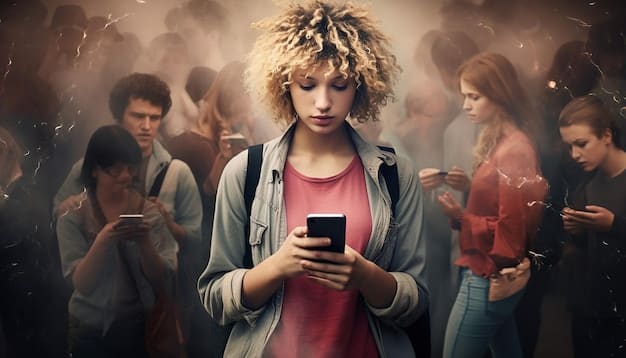The Impact of Social Media on Mental Health in the US: Latest Findings

Recent research indicates that social media’s impact on mental health in the US is multifaceted, presenting both risks, such as increased anxiety and depression, and potential benefits, like fostering community and support, with ongoing findings highlighting the complexity of its effects.
In an increasingly connected world, the omnipresence of social media has undeniably reshaped how we interact, communicate, and perceive ourselves. But what is the true impact of social media on mental health in the US: what are the latest findings telling us about this evolving relationship? This article delves into recent research and expert insights, exploring the nuanced ways digital platforms influence the psychological well-being of Americans.
Understanding the landscape of social media use in the US
The digital tapestry of the United States is deeply interwoven with social media. Millions of Americans across all age groups engage with platforms daily, forming a significant part of their social, professional, and personal lives. This widespread adoption, however, prompts critical questions about its psychological ramifications, moving beyond anecdotal observations to empirical evidence.
Recent statistics paint a clear picture of this pervasive usage. Data indicates that over 80% of US adults use social media, with younger demographics showing even higher rates of engagement. This isn’t just about passive consumption; it involves active participation, sharing of personal information, and constant interaction with a global audience. The sheer volume and intensity of this engagement underscore the importance of understanding its influence on psychological states.
Demographic trends in social media engagement
Usage patterns vary significantly across different age groups, genders, and socioeconomic backgrounds. Teenagers and young adults are often cited as the heaviest users, spending several hours a day on platforms like TikTok, Instagram, and Snapchat. However, older generations are also increasingly adopting social media, primarily Facebook, to connect with family and friends. This demographic diversity means that the impact on mental health likely isn’t uniform, requiring a more granular analysis.
- Adolescents and young adults: Higher engagement, potentially greater exposure to cyberbullying and unrealistic comparisons.
- Adults: Use for networking, news consumption, and maintaining relationships, with varied impacts based on individual coping mechanisms.
- Older adults: Primarily for social connection and information, generally reporting more positive experiences.
The evolving nature of platforms
Social media is not a monolithic entity. The features, algorithms, and primary functions of platforms like Facebook, X (formerly Twitter), Instagram, and TikTok differ considerably. Each platform cultivates its own unique digital environment, which can influence user behavior and, consequently, mental well-being differently. For instance, image-centric platforms might contribute more to body image issues, while news-heavy platforms could heighten anxiety related to current events.
Understanding these underlying usage patterns is foundational to dissecting the complex relationship between digital engagement and mental health. It allows researchers to move beyond broad generalizations and pinpoint specific interactions that may foster negative or positive emotional outcomes.
In summary, the pervasive and diverse nature of social media use in the US necessitates a careful examination of its psychological impact. The latest findings emphasize that the effects are not uniform, but rather are influenced by individual predispositions, specific platform characteristics, and the nature of user engagement.
Key research findings: negative impacts on mental health
Numerous studies have sought to quantify and qualify the detrimental effects of social media on mental well-being in the US. While the causal links are complex and often indirect, a growing body of evidence points to several consistent themes indicating negative associations, particularly concerning anxiety, depression, and self-esteem.
One prominent area of concern is the rise in feelings of inadequacy and low self-esteem. Social media often presents idealized versions of reality, where users curate their lives to appear perfect. Constant exposure to these highlight reels can lead individuals to engage in upward social comparison, fostering feelings of envy, inadequacy, and dissatisfaction with their own lives. This phenomenon is particularly prevalent among adolescents and young adults, whose identities are still developing.
Increased anxiety and depression
Research consistently shows a correlation between heavy social media use and increased symptoms of anxiety and depression, especially among younger populations. The pressure to maintain an online persona, fear of missing out (FOMO), and constant connectivity can contribute to chronic stress. The expectation of immediate responses and the incessant stream of notifications can disrupt sleep patterns, further exacerbating mental health issues.
- Fear of Missing Out (FOMO): The anxiety that one might miss rewarding experiences that others are having, often triggered by social media posts.
- Cyberbullying: Online harassment, which can have severe psychological consequences, including depression, anxiety, and even suicidal ideation.
- Sleep disruption: Blue light exposure from screens and the psychological arousal from engaging with content can interfere with sleep quality.
Body image concerns and eating disorders
Platforms heavily reliant on visual content, such as Instagram and TikTok, have been linked to increased body dissatisfaction and the development or exacerbation of eating disorders. Users are exposed to highly edited images of bodies that may be unrealistic or unattainable. This constant visual comparison can lead to negative self-perception, obsessive thoughts about appearance, and unhealthy eating behaviors.
Moreover, the comment sections and direct messaging features on these platforms can become breeding grounds for negative feedback, body shaming, and the promotion of unhealthy diet culture. The pressure to conform to perceived beauty standards disseminated through social media can be overwhelming and damaging to mental health.

The role of social comparison and self-esteem
The very design of social media platforms encourages social comparison. Users can instantly see the curated lives of friends, acquaintances, and even strangers. This constant benchmarking, often against unrealistic ideals, can chip away at self-esteem and foster feelings of inadequacy. The pursuit of likes and validation can become addictive, tying an individual’s sense of self-worth to ephemeral online metrics, leading to a precarious emotional state.
While some argue that social media merely reflects existing societal pressures, the digital environment amplifies these pressures by making comparisons constant, immediate, and often global. This amplification effect makes it harder for individuals, especially those with pre-existing vulnerabilities, to maintain a healthy sense of self. The latest findings confirm that these negative impacts are not isolated incidents but rather systemic challenges that warrant continued attention and intervention.
Potential positive aspects and emerging benefits
While the negative narrative often dominates discussions, recent findings also illuminate the potential positive aspects and emerging benefits of social media on mental health. Dismissing these platforms entirely would be an oversimplification, as they undeniably offer avenues for connection, support, and identity formation that can be crucial for well-being.
One significant positive aspect is the ability of social media to foster a sense of community and belonging. For individuals who may feel isolated or marginalized in their physical environments, online communities can provide invaluable support networks. People can connect with others who share similar experiences, hobbies, or challenges, leading to reduced feelings of loneliness and increased validation. This is particularly salient for those with rare conditions, niche interests, or who belong to minority groups, where finding understanding in person might be difficult.
Building social connections and support networks
Social media platforms can facilitate the maintenance of existing relationships, allowing friends and family to stay connected across geographical distances. They also enable the formation of new friendships and professional networks based on shared interests rather than just geographical proximity. These connections can serve as vital social support systems, offering emotional solace during difficult times and celebrating successes.
- Maintained relationships: Keeping up with distant friends and family.
- New connections: Forming friendships based on shared hobbies or experiences.
- Support groups: Accessing communities for health issues, personal challenges, or specific identities.
Access to mental health resources and awareness
Beyond personal connections, social media has become a powerful tool for disseminating mental health information and resources. Organizations and therapists use platforms to raise awareness, destigmatize mental illness, and share coping strategies. This accessibility can be life-changing for individuals who might otherwise lack the knowledge or means to seek professional help. Hashtags and trending topics can also bring critical mental health conversations to a wider audience, fostering empathy and understanding.
Furthermore, many individuals find solace in sharing their own mental health journeys online, contributing to a sense of collective experience and reducing feelings of isolation. This form of self-expression can be therapeutic and empowering.
Identity formation and self-expression
For young people especially, social media can serve as a space for identity exploration and self-expression. It allows them to experiment with different aspects of their personality, share their creative work, and find like-minded individuals. This process can contribute to a stronger sense of self and belonging, which are crucial components of positive mental health development. The ability to discover diverse perspectives and engage in meaningful discussions can also broaden one’s worldview.
While the risks are undeniable, it’s crucial to acknowledge that social media is not inherently detrimental. When used mindfully and constructively, these platforms can empower individuals, build strong social bonds, and act as significant conduits for mental health support and awareness. The key lies in understanding how to leverage these benefits while mitigating the known risks.
Vulnerable populations: who is most at risk?
While social media impacts a broad spectrum of the US population, certain demographic groups are disproportionately vulnerable to its negative mental health effects. Understanding these at-risk populations is crucial for developing targeted interventions and support strategies. Recent findings consistently point towards specific age groups and those with pre-existing conditions as being particularly susceptible.
Adolescents and young adults, generally considered to be between the ages of 10 and 24, are frequently identified as the most affected demographic. This period is characterized by significant brain development, identity formation, and increased susceptibility to peer influence. During these formative years, self-esteem is often fragile, and individuals are more prone to social comparison and external validation. The constant exposure to idealized realities, cyberbullying, and the pressure to conform online can severely disrupt healthy psychological development, leading to higher rates of anxiety, depression, and body image issues.
Adolescents and young adults (ages 10-24)
The intense developmental phase of adolescence makes this group particularly susceptible. Hormonal changes, evolving social dynamics, and the pressure to establish independence intertwine with ubiquitous social media use. This combination can create a perfect storm for mental health challenges. Studies have shown a strong correlation between increased social media use and reported feelings of loneliness and social isolation among this age group, despite being constantly connected digitally.
Individuals with pre-existing mental health conditions
For those already struggling with mental health issues such as anxiety disorders, depression, or eating disorders, social media can act as an exacerbating factor. The triggers for these conditions – social comparison, cyberbullying, or exposure to distressing content – are often amplified in online environments. For instance, individuals with anxiety might experience heightened symptoms due to the pressure of online performance or fear of negative feedback.
- Anxiety and Depression: Increased rumination on social shortcomings and fear of missing out.
- Eating Disorders: Exposure to thin-ideal imagery and diet culture content.
- Body Dysmorphia: Constant visual comparison and aesthetic pressures.
Children and early adolescents
While often less discussed than older adolescents, children and early adolescents (under 13) are also a concern. Their developing cognitive and emotional regulation skills make them less equipped to navigate the complexities and potential harms of social media. Exposure to inappropriate content, developmental aggression like cyberbullying, and excessive screen time can interfere with crucial developmental milestones, including face-to-face social skills and healthy emotional processing. Protecting this youngest demographic requires particularly vigilant parental guidance and platform responsibility.

Addressing the mental health impact of social media requires a nuanced understanding of these vulnerabilities. Interventions must be tailored to specific age groups and mental health statuses, emphasizing digital literacy, critical thinking about online content, and fostering resilience in the face of digital pressures. Recognizing who is most at risk is the first step toward creating a safer and healthier digital environment for all.
Policy implications and regulatory considerations
The growing body of evidence regarding social media’s impact on mental health in the US has inevitably propelled the conversation towards policy implications and regulatory considerations. As scientific findings accumulate, stakeholders—from government bodies to tech companies and advocacy groups—are increasingly exploring potential frameworks to mitigate harm and promote well-being online. However, balancing user safety with free speech and innovation presents complex challenges.
One significant area of focus is the protection of minors. Lawmakers are grappling with how to impose stricter age verification processes, limit algorithmic exposure to harmful content for young users, and potentially establish digital “curfews” or usage limits for adolescents. These discussions are often fraught with debates about parental rights, privacy concerns, and the feasibility of enforcement. The aim is to create a safer online environment for developing minds without stifling legitimate use and expression.
Age-appropriate design codes
Inspired by regulations in other countries, there’s growing momentum in the US for “age-appropriate design codes.” These codes would mandate that social media platforms design their services with the best interests of children and adolescents in mind. This could include default privacy settings, limitations on data collection from minors, and restrictions on features that promote excessive engagement, such as infinite scrolls or highly personalized recommendation algorithms that might lead to harmful content. The goal is to shift the onus of protection from individual users to the platforms themselves.
Data privacy and algorithmic transparency
Another crucial policy consideration revolves around data privacy and algorithmic transparency. How user data is collected, used, and shared can significantly impact mental health, particularly concerning targeted advertising that exploits vulnerabilities or algorithms that push users towards sensational or polarizing content. Calls for greater transparency in how algorithms work and more user control over their data are becoming louder. Increased transparency could allow users to better understand how content is curated for them, potentially reducing exposure to harmful echo chambers or addictive design features.
- Data collection limits: Restricting the types and amounts of data collected from users, especially minors.
- Algorithmic auditing: Requiring external audits of algorithms to ensure fairness and identify potential harms.
- User control over feeds: Giving users more customizable options to filter content and reduce addictive features.
Content moderation and accountability
The debate around content moderation remains contentious but is central to protecting mental health. Addressing cyberbullying, hate speech, and the proliferation of self-harm content requires robust policies and effective enforcement mechanisms from platforms. Governments are exploring ways to hold platforms more accountable for the content they host, potentially through fines or legal liabilities for failure to adequately moderate harmful material. However, defining “harmful content” without infringing on freedom of expression is a perpetual challenge that requires a nuanced, balanced approach.
Overall, the current policy landscape reflects a critical juncture. There’s a clear recognition that unchecked social media growth has mental health consequences that necessitate a thoughtful regulatory response. The latest findings underscore the urgency of these discussions, urging policymakers to act decisively while carefully navigating the complexities of digital governance.
Mitigation strategies and fostering digital well-being
Given the nuanced nature of social media’s impact on mental health, a multi-faceted approach to mitigation and fostering digital well-being is essential. This involves not only policy-level interventions but also individual strategies, educational initiatives, and platform-level changes. The aim is to empower users to engage with social media more mindfully and constructively, thereby minimizing risks and maximizing potential benefits.
At the individual level, developing digital literacy and critical thinking skills is paramount. Users need to be equipped to recognize and question the curated realities presented online, understand the persuasive design elements of platforms, and manage their own time and engagement effectively. This includes being aware of how social comparison operates, identifying signs of compulsive use, and understanding the importance of taking regular digital breaks.
Promoting digital literacy and media education
Educational institutions and parents play a crucial role in teaching young people how to navigate the digital world safely and healthily. This goes beyond simply warning about stranger danger; it involves fostering an analytical approach to online content, understanding privacy settings, and promoting responsible online interactions. Curricula that integrate media literacy into routine education can help students distinguish between factual information and opinion, recognize manipulative tactics, and develop a healthy skepticism towards online portrayals of life.
- Critical evaluation of content: Teaching users to question what they see and read online.
- Understanding algorithms: Explaining how feeds are personalized and why certain content appears.
- Privacy management: Educating on managing personal data and privacy settings.
Encouraging mindful social media use
Mindfulness practices, often associated with meditation, can be adapted to foster more intentional social media use. This means encouraging users to be aware of their emotions and motivations before, during, and after engaging with platforms. Setting boundaries, designating “screen-free” times, and actively choosing who to follow can significantly improve one’s digital experience. Tools provided by platforms, such as usage tracking and notification controls, can also support these efforts.
For example, instead of endlessly scrolling, users might be encouraged to check social media only for specific purposes, such as connecting with a particular friend or checking a specific group. This shifts the engagement from passive consumption to active interaction, which tends to be more enriching and less detrimental to mental health.
Platform responsibility and design changes
Social media companies hold significant power in shaping user behavior through their design choices. There’s a growing call for platforms to prioritize user well-being over engagement metrics. This could involve redesigning features to reduce addictiveness, providing more prominent mental health resources within their apps, and implementing stricter content moderation. Some platforms have already started introducing features like “take a break” reminders, “quiet mode” functionalities, and tools that limit exposure to potentially harmful content.
Ultimately, fostering digital well-being requires a collective effort. Individuals must take responsibility for their usage patterns, educators must equip the next generation with critical skills, and platforms must evolve to create healthier digital environments. The latest findings reinforce that while the challenges are significant, proactive mitigation strategies can lead to a more positive and balanced relationship with social media.
Future directions: research, technology, and society
The relationship between social media and mental health is not static; it is an ever-evolving landscape shaped by technological innovation, shifting societal norms, and continuous scientific inquiry. Looking ahead, understanding this dynamic requires anticipating future trends in research, the development of new technologies, and a societal commitment to promoting digital well-being.
Future research will undoubtedly delve deeper into causal mechanisms, moving beyond correlations to identify specific pathways through which social media influences psychological states. This will involve more longitudinal studies, sophisticated data analysis techniques, and potentially neurobiological investigations to understand how digital interactions affect brain chemistry and structure. Research will also need to keep pace with the rapid proliferation of new platforms and features, as each presents unique challenges and opportunities for mental health impact.
Technological advancements and emerging platforms
The advent of virtual reality (VR), augmented reality (AR), and the metaverse presents new frontiers for social interaction and, consequently, new questions for mental health. As digital environments become more immersive, the lines between online and offline realities will blur further. Researchers will need to explore how prolonged engagement in these hyper-realistic digital spaces affects identity, social cognition, and emotional regulation. Will these technologies offer new avenues for therapeutic interventions, or will they introduce unprecedented mental health challenges?
Similarly, the rise of artificial intelligence (AI) within social media platforms, from content recommendation algorithms to AI companions, warrants close examination. While AI can personalize experiences, it also raises concerns about potential manipulation, filter bubbles, and the authenticity of online interactions. Understanding the psychological impact of interacting with increasingly sophisticated AI will be critical.
Societal adaptation and preventive measures
Society’s adaptation to pervasive digital connectivity will be a key factor in determining the long-term impact on mental health. This includes the normalization of digital literacy from an early age, widespread adoption of mindful tech habits, and a cultural shift towards valuing authentic offline connections as much as online engagement. Preventive measures, such as school-based programs focused on resilience and emotional intelligence in a digital age, will become increasingly important.
Furthermore, the mental health community must continue to innovate in how it leverages technology for support and intervention. Teletherapy, online mental health communities, and app-based interventions are already becoming mainstream. Future developments could include AI-powered diagnostic tools, personalized digital therapeutics, and advanced monitoring systems that can proactively identify individuals at risk based on their online behavior and offer timely support.
In essence, the future of social media and mental health is a shared responsibility. It demands ongoing vigilance from researchers, ethical innovation from technologists, thoughtful regulation from policymakers, and conscious engagement from individuals. By working collaboratively, society can strive towards a future where digital platforms enhance, rather than detract from, overall well-being.
| Key Finding | Brief Description |
|---|---|
| 📊 Increased Negative Impact | Studies link heavy social media use to higher rates of anxiety, depression, and low self-esteem, especially among youth. |
| 💖 Positive Connections | Platforms can foster community, provide social support, and offer access to mental health resources. |
| 🧒 Vulnerable Groups | Adolescents and those with pre-existing mental health conditions are most susceptible to negative effects. |
| ⚖️ Policy & Mitigation | Calls for age-appropriate design, data transparency, and digital literacy to promote healthier use are growing. |
Frequently asked questions about social media and mental health
While social media doesn’t directly cause mental illness, research indicates a strong correlation between heavy use and increased symptoms of anxiety, depression, and low self-esteem. It can act as an exacerbating factor, particularly for vulnerable individuals, due to phenomena like social comparison, cyberbullying, and fear of missing out (FOMO).
Adolescents and young adults (roughly ages 10-24) are consistently identified as the most affected demographic. This is primarily due to their developmental stage, where identity formation, self-esteem, and susceptibility to peer influence are heightened. However, negative impacts can be observed across all age groups depending on usage patterns.
Yes, social media can have positive effects. It can foster community and support networks, particularly for marginalized groups, help users maintain long-distance relationships, and serve as a valuable platform for disseminating mental health resources and awareness. It also offers avenues for self-expression and identity exploration.
FOMO is the anxiety that one might miss rewarding experiences that others are having, often triggered by curated social media posts. It contributes to feelings of inadequacy, envy, and increased screen time. Constantly seeing others’ highlights can lead to dissatisfaction with one’s own life, impacting overall mental well-being.
Individuals can practice mindful use by setting time limits, taking regular digital breaks, and curating their feeds to include positive content. Developing digital literacy, critically evaluating what they see online, and prioritizing real-world connections are also key strategies to foster healthier engagement and protect mental well-being.
A balancing act: shaping a healthier digital future
The journey to understanding the impact of social media on mental health in the US: what are the latest findings remains ongoing, revealing a complex tapestry of both challenges and opportunities. While the risks of increased anxiety, depression, and social comparison are evident, so too are the undeniable benefits of connection, community, and access to vital information. As we move forward, the collective responsibility of individuals, platforms, policymakers, and educators will be paramount in shaping a digital future that prioritizes well-being. By fostering digital literacy, promoting mindful engagement, and advocating for ethical design, we can strive to harness the power of social media for good, ensuring it serves as a tool for empowerment and connection, rather than a detriment to our collective mental health.





